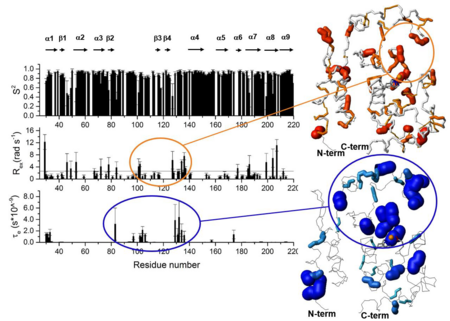Structural characterization of zinc-bound Zmp1, a zinc-dependent metalloprotease secreted by Clostridium difficile
Jeffrey T. Rubino, Manuele Martinelli, Francesca Cantini, Andrea Castagnetti, Rosanna Leuzzi, Lucia Banci and Maria Scarselli [1]
Molecular Tour
Clostridium difficile is a Gram-positive spore-forming anaerobic bacterium which emerged in the last decades as a major cause of antibiotic-associated diarrhea worldwide. Tendency of infection to recur and increase in antibiotic-resistant strains pose new challenges to C. difficile treatment. New-generation small molecules, use of pro-biotics, and fecal microbiota transplantation are all emerging options for prevention and cure of C. difficile infection. Beside the development of new antibiotics, virulence targeting factors and vaccines represent promising strategies, which stimulate the research of new potential antigens and targets for drug design.
C. difficile releases the zinc-dependent metalloprotease Zmp1 in the extracellular medium. Different possible targets have been identified for this protein, including the human fibrinogen, leading to the hypothesis that it could play multiple roles during bacterial host infection. This protein can indeed contribute to several aspects of C. difficile pathogenesis ranging from the damage of host tissues, through hydrolysis of the components of extracellular matrix, to the release and cell wall attachment of virulence factors.
The structural and dynamic characterization of substrate-free Zmp1 through NMR have revealed that two regions of the protein are affected by local mobility. Such dynamic behavior could play a role in substrate specificity and offers the possibility to investigate and develop specific inhibitors or mutants, that acting on the internal mobility, may impair the activity of C. difficile Zmp1 contributing to prevent the dissemination of this pathogen.
In the field of vaccine development against Clostridium difficile, the NMR assignment and the solution structure of Zmp1, together with its dynamic characterization, can be useful for mapping residues involved in important functions such as eliciting bactericidal antibodies and it will provide insight into improved vaccine antigen design with higher stability and improved epitope presentation.
(Alpha Helices,
Beta Strands ,
Loops ,
Turns.)
is shown. The amino acids in the active site are labeled.
Parameters characterizing the overall and internal mobility of Zn-bound
Zmp1 within the Lipari-Szabo model (see static image below). The ‘’Model-Free’’ formalism parameterizes
intramolecular dynamics in terms of an overall tumbling correlation time tc, generalized
order parameters S2
, and of the correlation time for internal motions, which can be
considered as arising from two components, one describing faster (tf) and one slower (ts)
motions (collectively called te), but always faster than tec. Motions on intermediate time
scales (ms to ts ), characteristic of exchange processes (Rex), may also contribute to
transverse relaxation through the fluctuation of the chemical environment of a nucleus.
The line reported in the graph of Rex represents the average value. The secondary
structure elements are reported at the top. Residues which experience local mobility (Rex
or te) are also mapped into the Zmp1 structure in orange and blue respectively. The
radius of the atom bonds is proportional to the magnitude of these values. Zinc is
represented as orange sphere, binding residues as sticks.
PDB reference: Solution structure of Zmp1, a zinc-dependent metalloprotease secreted by Clostridium difficile, 2n6j.


